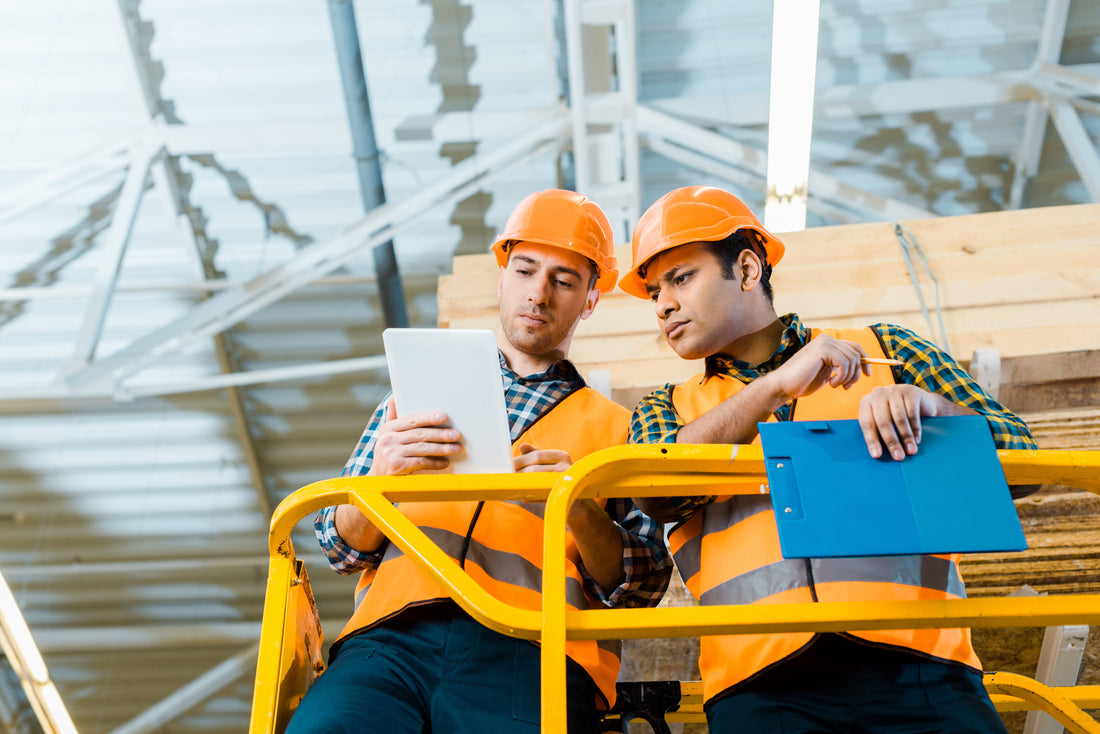What is an Aerial Work Platform?
An aerial work platform (AWP), also known as an aerial lift, elevating work platform (EWP), cherry picker, bucket truck, or mobile elevating work platform (MEWP), is a mechanical device used to provide temporary access for people or equipment to inaccessible areas, usually at height. AWPs are designed to lift limited weights, usually less than a ton, and are usually capable of being set up and operated by a single person. They are commonly used for maintenance, construction and warehouse work, along with other tasks that require temporary, flexible access to high places.
Types of AWPs
There are several distinct types of AWPs, and each machine has its own pros and cons. Selecting the proper AWP varies based on the specifics of the task, such as working inside or outside, working height and in particular, the nature of the project. The features of each type make them more or less desirable for different tasks.- Boom Lifts: These are characterized by a hydraulic arm with a bucket at the end, allowing for vertical and horizontal reach.
- Pros: Great for reaching high areas, can be used on rough terrain, and some models offer 360-degree rotation
- Cons: Limited outreach compared to other AWPs, and may have restricted access in tight spaces
- Articulating Boom Lifts: Similar to boom lifts, but with multiple sections that articulate, providing more flexibility in reaching difficult areas.
- Pros: Provide flexibility for reaching difficult areas due to multiple articulating sections
- Cons: Limited outreach compared to telescopic boom lifts, and may have restricted access in tight spaces
- Telescopic Boom Lifts: These have a straight arm that extends telescopically, offering great horizontal reach.
- Pros: Excellent horizontal reach, making them suitable for areas with limited access
- Cons: Limited flexibility compared to articulating boom lifts, and may have restricted access in tight spaces
- Scissor Lifts: They operate by a folding mechanism, allowing the platform to move vertically. They are ideal for vertical lifting in a straight line.
- Pros: Ideal for vertical lifting in a straight line, and some models offer large platform space for equipment
- Cons: Limited outreach and cannot reach over obstacles due to their vertical lift mechanism
- Vertical Mast Lifts: These provide vertical access in a compact and maneuverable design, suitable for indoor use and tight spaces.
- Pros: Compact and maneuverable, suitable for indoor use and tight spaces
- Cons: Limited to vertical access only, not suitable for reaching over obstacles
- Towable Lifts: These are portable and can be towed behind a vehicle, offering flexibility in transportation.
- Pros: Portable and can be towed behind a vehicle, offering flexibility in transportation
- Cons: Limited to specific weight and height capacities, and may require a towing vehicle
- Personnel Lifts: Electric-powered and designed for indoor use, they are suitable for tight or confined spaces.
- Pros: Electric-powered and designed for indoor use, suitable for tight or confined spaces
- Cons: Limited to specific weight and height capacities, and not suitable for outdoor rough terrain
What are MEWPs?
Mobile Elevated Work Platforms or MEWPs are platforms that were previously known as Aerial Work Platforms (AWPs) until the American National Standards Institute (ANSI) updated the terminology. Like other AWPs, MEWPs encompass a wide range of equipment used to provide powered access to elevated work areas and are classified based on group and type. The group classification is determined by the location of the platform in relation to the tipping line, with Group A MEWPs having a platform that moves vertically while staying inside the tipping lines, and Group B MEWPs moving their platforms beyond the tipping line. The type classification is based on how the machine is able to move around, with Type 1 MEWPs being able to move only when the platform is in the stowed position, Type 2 MEWPs having additional features for movement, and Type 3 MEWPs being able to travel with the platform elevated and controlled from within the work platform.
Types of MEWPs
There are multiple types of MEWPs and like with other aerial lifts, the proper machine depends on the task at hand. Interestingly, MEWPs rely on classification standards to differentiate the types of machines. Each type of MEWP is designed for specific purposes, and understanding their classifications is important for selecting the appropriate machine for a job.
- Type 1 MEWPs: These can only move when the platform is in the stowed position.
- Examples include vertical lifts and scissor lifts, which are suitable for tasks requiring vertical access within the tipping lines, such as maintenance and construction work.
- Type 2 MEWPs: They can travel with the platform in an elevated position and are controlled from the chassis area.
- Examples include certain boom lifts, providing flexibility for tasks that require elevated access and movement, such as maintenance and installation work.
- Type 3 MEWPs: They can also travel with the platform elevated, but are controlled from within the work platform.
- Examples include self-propelled articulating and telescopic booms, offering flexibility and outreach for tasks that require elevated access and maneuverability, such as construction, electrical repair, and firefighting.
AWPs vs MEWPs
The principal difference between AWPs and MEWPs is terminology and classification. Previously, the term AWP was used to refer to various elevated work platforms such as scissor lifts and boom lifts. However, the new term MEWP, has been introduced to encompass a broader range of equipment. MEWPs are now categorized based on group and type, whereas AWPs were identified by the name of the aerial lift. For example, scissor lifts and boom lifts, are not only AWPs, but specific types of MEWPs, and the term MEWP is now used as the more comprehensive and standardized term for this category of aerial lift equipment.
Industries Using Various Types of AWPs and MEWPs
AWPs and MEWPs are increasingly common in a variety of industries because they provide safe access to areas that would otherwise be difficult to reach. Aerial lifts provide the unique ability to cut on-the-ground costs, which makes the investment in the equipment pay for itself very quickly in productivity gains. As a result, many industries rely on the family of AWPs to get the job done each and every day.
-
Construction Sites: Especially for sites requiring intense detail and focused work in high places, these machines allow workers to concentrate on their duties while the lift supports them and their tools, for however long the work ends up taking.
- Telecommunications: Beyond construction, aerial work platforms are also fantastic at increasing the speed and efficiency of telecommunication asset maintenance. With an AWP, workers have the advantage of being closer to the affected lines without compromising their safety. The lift allows them to bring all required tools up with them safely and provides an incident-free maintenance experience.
- General Building Maintenance: Similar to their uses in telecommunication and construction, one of the primary advantages of. For those working in building maintenance, AWPs prevent workers from needing to carry all of their equipment themselves; the lift can support both them and their tools, no matter how big a job they’re doing, which lets teams focus on the job at hand.
- Warehousing: AWPs are one of the easiest ways for employees to evaluate or retrieve inventory that is stored on the higher shelves of your warehouse facility, which means better inventory management, faster processing and improved employee safety.
- Agriculture: AWPs help harvest crops from high trees, maintain the foliage of residential trees, or complete any other task at an elevated height. Especially in agriculture, where much of the equipment can be dangerous if mishandled, AWPs allow for the safe storage of unused equipment, eliminating any worry about it falling and hurting someone below.
AWPs and MEWPs are crucial in numerous industries for their safety and efficiency in high, hard to reach tasks. Understanding the types and their applications helps in choosing the right equipment for specific needs. Of course, Aerial Equipment Parts is always here and ready to help with any questions or concerns you may have.
Finally, if you need to replace any of your AWP parts, then search our inventory to find the right part for your lift today. Plus, keep in mind that we keep our inventory stocked in a warehouse located in the U.S., so when we say fast shipping, we mean it. And, if you have any questions, just call our team at 303-704-7000 (or email us at contact@aerialequipmentparts.com), where you can speak with an experienced person with years of industry knowledge if you have any questions.


